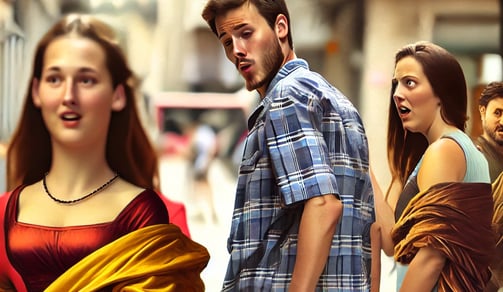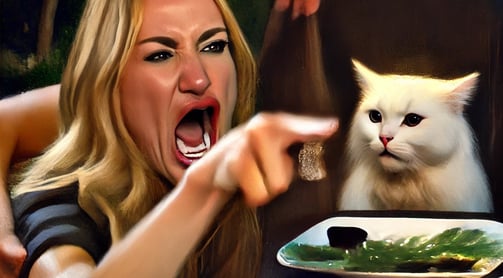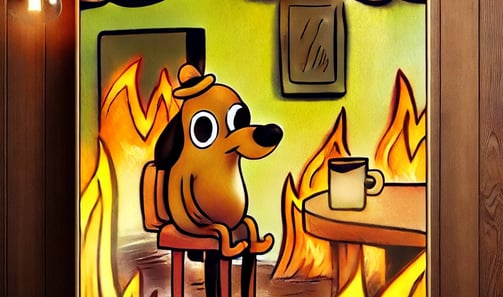The Glorious History of Memes: From Cavemen to Cyberlords
Step into the hilariously rich history of memes with The Glorious History of Memes: From Cavemen to Cyberlords. This blog takes you on an epic journey through time—tracing the evolution of humor and shared cultural moments from primitive cave paintings (the OG viral content) to the high-speed chaos of internet memes. Along the way, we unpack how memes have shaped communication, identity, and even global movements. Whether you’re a meme aficionado, a history buff, or just in it for the laughs, this is your ultimate guide to the timeless art of going viral.
DIGITAL MARKETINGBLOG ARCHIVE
Usha Menon
3/9/20254 min read
The Glorious History of Memes: From Cavemen to Cyberlords
Ah, memes! The digital equivalent of a caveman’s inside joke—except instead of being carved on a rock, they’re now spread at the speed of light across the internet. If aliens ever study human civilization, they’ll probably conclude that our primary form of communication is a mix of SpongeBob screenshots, cat pictures, and confused math lady GIFs. But how did we get here? Let’s dive into the ridiculous yet fascinating history of memes and their ever-evolving relevance.
The Past: The Dawn of Dumb Humor
From early examples like folklore and religious parables to political cartoons, the impulse to share and remix ideas is timeless. However, the internet has undoubtedly accelerated the evolution of memes, creating a global playground for creativity and viral content unlike anything seen before.
Before the internet, memes were still a thing—they just didn’t have WiFi. The word “meme” was first coined by biologist Richard Dawkins in 1976 in his book The Selfish Gene. He described it as an idea, behavior, or style that spreads from person to person. In essence, even cavemen were making memes—probably drawing funny-looking mammoths on cave walls and laughing at each other’s stick figures.
Fast forward to the medieval times, and you had tapestry memes—artists subtly roasting kings or depicting peasants with expressions that could rival modern “distracted boyfriend” memes. Even Shakespeare was a meme lord, inventing phrases that still circulate today like "wild goose chase" or "all that glitters is not gold" (which sounds like an early attempt at life advice memes).
Then came the 20th century, where memes took on a physical form in newspapers and posters. Think of the classic "I Want You" Uncle Sam recruitment poster—it was basically the World War I version of a viral meme, minus the Minions.
The Present: The Golden Age of Chaos
Welcome to today, where memes dominate every aspect of our lives. Whether you’re laughing at political satire, shedding a tear over nostalgia memes, or questioning reality with absurdist humor, memes are everywhere. The rise of social media platforms—Facebook, Twitter, Instagram, TikTok, and Reddit—has turned memes into the ultimate global currency of humor.
Some legendary memes have stood the test of time, including:
The “Distracted Boyfriend” (the Renaissance painting of our era)
The “Woman Yelling at a Cat” (a masterpiece in miscommunication)
The “This Is Fine” Dog (basically an entire mood since 2020)
Modern internet culture is practically defined by memes. They serve as a shared language, a shorthand for expressing complex emotions, and a potent tool for social commentary. Understanding meme origins can often unlock deeper insights into pop culture trends and societal anxieties. The speed at which viral memes spread and morph is a testament to the interconnected nature of cyber culture, demonstrating how quickly ideas can take root and spread across the globe, influencing everything from political discourse to advertising strategies.
With meme templates evolving at the speed of light, internet culture has become a never-ending game of who can be the funniest, fastest. Blink, and you’ll miss the latest trend. But no worries—there’s always another meme coming in the next five seconds.
The Future: AI-Generated Nonsense?
What does the future hold for memes? If current trends are anything to go by, AI will likely take over meme-making. Imagine asking ChatGPT to generate memes based on your mood, and voilà! Personalized, 100% relatable memes at your fingertips.
Meanwhile, the Metaverse might turn memes into interactive experiences, allowing you to literally step inside a meme. Want to become the distracted boyfriend? Done. Want to be the cat in “Woman Yelling at a Cat”? You got it. The possibilities are endless.
And let’s not forget about NFT memes (because of course, someone had to monetize this). In the future, you might have to own a meme before you can share it. Imagine getting sued for illegally downloading a “Crying Michael Jordan” meme. The horror!
Conclusion: Long Live Memes!
From the crude yet expressive cave paintings to the fast-paced dynamics of modern internet culture, the history of memes demonstrates how shared ideas and jokes have always been a part of human interaction.
Beyond being just funny memes, the impact of memes extends into areas like meme marketing, where brands utilize them for relatability and engagement. Memes act as social commentary, poking fun at everything from politics to daily struggles, and their future promises even more integration into digital communication and analysis. As internet phenomena continue to evolve, the future of memes may see them becoming tools for digital art, activism, and even academic study, proving that these seemingly simple creations have a profound role in shaping our modern world.
Memes have come a long way—from cave paintings to TikTok trends—and they’re not going anywhere. As long as humans exist, we’ll continue finding creative ways to express ourselves, roast each other, and cope with life’s absurdity through humor. So, raise your digital glasses (or Pepe the Frog emojis) and toast to the never-ending evolution of memes. May our descendants continue to share Grumpy Cat in the year 3000.






